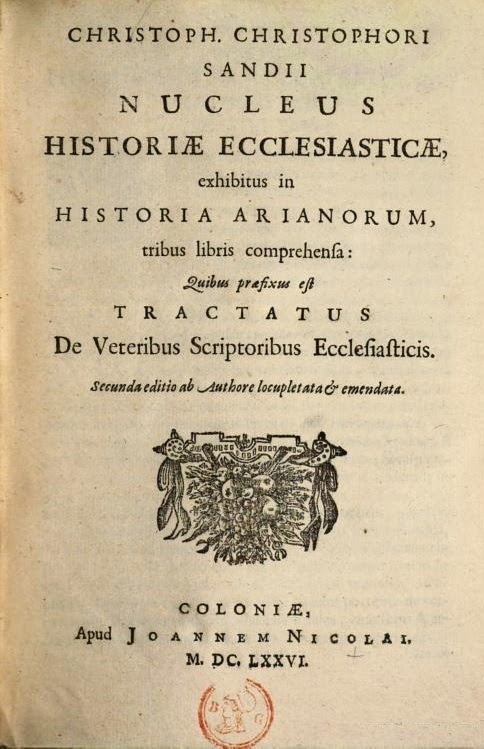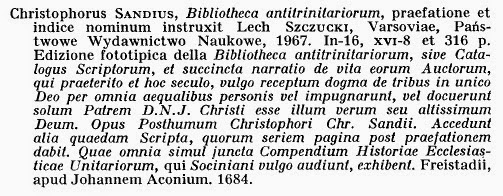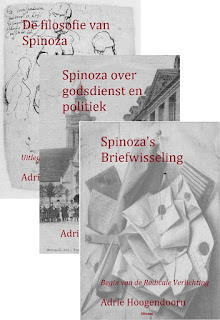Christopher Sandius jr. (1644 - 1680) kende hij Spinoza persoonlijk? Hoorde hij tot de kring van Spinoza?
Dat beweert de Poolse geleerde Lech Szczucki in zijn “W krêgu spinozjañskim (Krzysztof Sandius junior)” [In de Spinozistische cirkel: Christopher Sandius jr.]. Hij is de enige die daar ooit mee kwam.
Het blog van afgelopen donderdag met informatie van Frank Mertens over de bibliotheek van Johannes Bouwmeester, liet zien dat die ook vier boeken bezat van Christopher Sandius – ze worden daar vermeld. Ook Spinoza had een werk van Sandius– volgens Wiep van Bunge het enige socinaanse [sic] boek in zijn boekerij [cf. Socinianisme in de Nederlanden]. Dat betreffende boek wordt door Jacob van Sluis & Tonnis Musschenga aldus beschreven:
[Quarto] 18. Sandii Nucleus Hist. Eccles. 1676 Col. Cum Tractatu de Script. Vet. Eccles.
Christoph. Christophori Sandii Nucleus historiæ ecclesiasticæ, exhibitus in historia Arianorum,
tribus libris comprehensa: quibus praefixus est tractatus de veteribus scriptoribus ecclesiasticis. –
Secunda editio ab authore locupletata & emendata. – Coloniæ: apud Joannem Nicolai, 1676
Auteur: Christophorus Christophori Sandius (1644-1680)
Drukker: Nicolai, Joannes, Keulen, 1676-1678
Omvang: [8],436, [20] p.
Catalogus Te Winkel nr. 042 (= Freudenthal 042, Aler 127)
Exemplaar Spinozahuis geschenk van G. baron Rosenthal.

Frank Mertens schreef voorts: “Soms wordt ook beweerd dat Sandius en Spinoza elkaar persoonlijk gekend hebben, al heb ik daarvan nooit enig bewijs gevonden, maar het lijkt me wel de moeite om te onderzoeken in hoeverre deze onderbelichte denker invloed uitgeoefend zou kunnen hebben op de kring rond Spinoza.”
Die opmerking maakte mij nieuwsgierig en deed me op speurtocht gaan naar wat daarover eventueel op internet te vinden is. Zou Spinoza dat boek dat verscheen in het jaar voor zijn dood zelf hebben aangeschaft, of zou hij het van de auteur hebben ontvangen daar ze elkaar kenden?
Over wie Christopher Sandius was is snel duidelijkheid te krijgen.
Christoph Sand was in het Pruisische Köningsberg geboren. Zijn vader, Christopher Sandius Sr., een hoge bestuursambtenaar in Konigsbergen, zou nogal streng geweest zijn en zijn zoon een gedegen opleiding verschaft hebben [zie wikisource over de vader]. Sr. kreeg later ontslag wegens verdenking van anti-trinitarische sympathieën. Jr. verhuisde naar Amsterdam waar hij aan de kost kwam als vertaler, redacteur en uitgever, o.a. van sociniaanse werken zonder dat hij overigens zelf sociniaan zou zijn. Hij werd goed bekend onder Europese intellectuelen. Zijn naam latiniseerde hij in Christophorus Sandius, maar hij zou tijdens zijn verblijf in Nederland ook bekend zijn geweest als Christof Van den Sand. Hij stond achter het arianisme uit de begintijd van het christendom. Hij stond op goede voet met Poolse socinianen als Andrzej Wiszowaty en Stanislaw Lubieniecki.
Werk van zijn hand:
Hij zou mogelijk betrokken zijn geweest bij het werk van Frans Kuyper (ca.1629-1691) Bibliotheca Fratrum Polonorum quos Unitarios vocant (1656 [i.e. ca. 1668) [archive.org]
• 1669 Nucleus
Historiae Ecclesiasticae, in 2 vols. 8vo, herdruk Colonia [Keulen], in 1676
[books.google]:
uitgebreide herdruk in Londen in 1681.
• 1669 Interpretationes paradoxae IV.
Evangeliorum - Cosmopoli, apud Libertum Pacificum [books.google]
- editie 1670 [books.google]
• 1669 Centuria Epigrammatum.
• 1671 Tractatus de Origine Animae. [books.google]
• 1677 Notae et Observationes in G.
J. Vossium de Historicis Latinis.
• 1678 Confessio Fidei de Deo Patre,
Filio, et Spiritu Sancto, secundum Scripturam,
 • 1684 Bibliotheca Anti-trinitariorum:
sive catalogus scriptorum et succinta narratio de vita eorum Auctorum, qui
praeterito et hoc seculo, vulgo receptum dogma de tribus in unico Deo per omnia
aequalibus personis vel impugnarunt vel docuerunt salum Patrem D.N.J. Christi
esse illum verum seu altissimum, Freistadt [=Amsterdam], apud Johannem Aconium,
1684, 12mo, [books.google]
• 1684 Bibliotheca Anti-trinitariorum:
sive catalogus scriptorum et succinta narratio de vita eorum Auctorum, qui
praeterito et hoc seculo, vulgo receptum dogma de tribus in unico Deo per omnia
aequalibus personis vel impugnarunt vel docuerunt salum Patrem D.N.J. Christi
esse illum verum seu altissimum, Freistadt [=Amsterdam], apud Johannem Aconium,
1684, 12mo, [books.google]
Bevat veel informatie over Poolse socinianen. Postuum uitgegeven door Benedykt
Wiszowaty, achterkleinzoon van Fausto Sozzini [Wiki]
Zie de gedigitaliseerde uitgaven van Christoph Sand bij het Münchener DigitaliserungsZentrrum
En dan kom je op wiki en ook elders tegen (b.v. hier):
Sandius Jr. also enjoyed close relationship with Benedictus Spinoza especially at the end of his life, when he became known as one of philosopher's most faithful followers. Between 1676-1680 he defended the anonymous author of the Tractatus theologico-politicus in correspondence with the Catholic theologian Pierre Daniel Huet.
Deze bewering gaat terug op degene die waarschijnlijk Sandius het meest bestudeerd heeft: de Pool Lech Szczucki van de Universiteit van Warschau. Verwezen wordt naar dit artikel in het Pools van hem, uit het Engelse abstract waarvan het bovenstaande vetgedrukte een letterlijk citaat is:
Szczucki L. “In the Spinozian Circle (Christopher Sandius Jr),” In: Przeglad Filozoficzno-Literacki (Philosophical/Literary Review) 2007, vol: 6, number: 3-4(18), pages: 289-311 [Cf. en cf.]
Maar veertig jaar eerder had hij al gepubliceerd (ik begon er het blog mee):
L. Szczucki, "W kregu spinozjariskim (Krzysztof Sandius, Junior)" [In the Spinozian Circle (Christopher Sandius Jr) in: Studia i Materialy z Dziejów Nauki Polskiej, seria A, zest. 12 (1968), p. 157-75.
Deze tekst is - waarschijnlijk ongewijzigd - opgenomen in het volgende boek:
Szczucki, Lech, "W kregu spinozjanskim (Krzysztof Sandius junior)" In: Nonkonformiœci religijni XVI i XVII wieku. Studia i szkice. Warszawa: Polska Akad. Nauk, Instytut Filozofii i Socjologii, 1993. [167 pp.], p. 105-131 [volgens de Duitse Spinoza bibliografie en books.google. En zie, dit boek is door de Unitaristische Universele Gemeenschap in de Republiek Polen als PDF op internet geplaatst en daarin is dus kennis te nemen van dat oorspronkelijke artikel - ik ga er zo dadelijk iets op in]
In zijn “Socinian historiography in the late 17th century,” het hoofdstuk dat Lech Szczucki bijdroeg aan: Frank Forrester Church & Timothy Francis George (Eds.), Continuity and Discontinuity in Church History: Essays Presented to George Huntston Williams on the Occasion of His 65th Birthday. BRILL, 1979 [books.google] kondigt hij aan dat en waarom hij zijn stuk uit 1968 zal actualiseren.
Na een paragraaf II (vanaf p. 288) over Benedykt Wiszowaty en diens Medulla historiae ecclesiasticae, is de volgende paragraaf III (vanaf p. 292) gewijd aan Christopher Sandius en in z’n beknoptheid zeer informatief:
“The very title, Medulla
historiae ecclesiarticae, seems an allusion to a celebrated work of the
second half of the seventeenth century, the Nucleus
historiae ecclesiasticae by Christopher Sandius, Jr., (1644-80). This
fascinating figure was a "proof-reader" in Dutch printing shops, a
student of Christian antiquity and a thinker in his own right. Towards the end
of his life he tried to wed his decidedly Platonist-inspired philosophical
outlook with the ideas of Spinoza, whom, for that matter, he knew personally.
He has already been the subject of a study of mine and I intend to return to
him given that interesting new evidence about him has now come to light.16
Here it is enough to say that his Nucleus historiae ecclesiasticae (first
ed., 1668, second ed. enlarged and revised, 1676; Appendix addendorum, confirmandorum et emendandorum ad Nucleum
historiae ecclesiasticae, 1678), which claimed the attention of the likes
of Spinoza and Newton, represented an attempt to reinstate the
"Arian" and "Arianizing" currents in the history of
Christianity, the basic accent being placed on hristological rather than Trinitological
issues. Despite the warm feelings he entertained for the Socinians (he himself
never belonged to any church) and despite his intimate friendship with many of
them and with Andrzej and Benedykt Wiszowaty in particular, Sandius repeatedly
emphasized the point where he and the Polish Brethren parted company. A firm
believer in the pre-existence of Christ (it is worth stressing in passing that
the description of Sandius as an "Arian" is none too accurate), he
also insisted that Faustus Socinus' doctrine de Verbo was an utterly new and completely unprecedented development
in the history of Christianity. Andrzej Wiszowaty took issue with Sandius'
Christological views in a separate treatise, now lost, and he answered his Nucleus in a dissertation, also lost,
entitled In Christophori Sandii Nucleum
historiae ecclesiasticae animadversiones. 17 It seems likely,
therefore, that Benedykt Wiszowaty, having inherited his father's papers, could
have found in them the inspiration to write his treatise.
It was this that I had in mind in speaking of Andrzej Wiszowaty's probable
contribution to Medulla historiae
ecclesiasticae.
16 L. Szczucki, "W kregu spinozjanskim (Krzysztof Sandius, Junior)" ("In Spinozan Circles—Krzysztof Sandius, Junior"). Studia i materialy z dziejów nauki polskiej, seria A, zest. 12 (1968), 157-73.
17 C. Sandius, Bibliotheca antitrinitariorum, 147-48.
Het is jammer dat Szczucki zijn vervolgstuk over Sandius niet weer in het Engels, maar uitsluitend in het Pools in de openbaarheid bracht. Maar zou het wel zo ingrijpend vernieuwd zijn?
Want als hij met behoud van dezelfde titel als die van zijn versie van 1968 in 2007 een zgn. geactualiseerde versie zou hebben gebracht vanwege “that interesting new evidence” (beide in het Pools), is het dan niet enigszins merkwaardig dat juist het eerdere artikel, zoals het was opgenomen in zijn boek Nonkonformiœci religijni XVI i XVII wieku uit 1993 (dus van voor die actualisering), vorig jaar in het Hongaars werd vertaald als Lech Szczucki, “Ifj. Christophorus Sandius és Spinoza,” en werd opgenomen in: Békés Enikõ & Szilágyi Emõke Rita (Eds.), Latinitas Polona. A latin nyelv szerepe és jelentõsége a történelmi Lengyelország kora újkori irodalmában [De rol en het belang van de Latijnse taal in de Poolse vroegmoderne literatuur]. Budapest, 2014, p. 213 -232 [PDF]
Ik vind het niet eenvoudig om (m.b.v. google-vertaalfunctie uit de Poolse en Hongaarse versies) daarin de evidentie te ontdekken dat Sandius, behalve dat hij intensief met Pierre-Daniel Huet over de TTP correspondeerde en daarin de zienswijze van Spinoza’s Bijbelhermeneutiek verdedigde, dat zou hebben gedaan op basis van een persoonlijke connectie met Spinoza.
Voor zover ik het begrijp leidt Szczucki die nauwe connectie vooral af uit de diepgaande kennis van Spinoza’s leer die Sandius in die correspondentie met Huet ten toon spreidde; hij moet volgens hem wel hebben beschikt over inside information b.v. door inzage te hebben gehad in conceptteksten. Dat afgezet tegen de grote voorzichtigheid van Spinoza, kan het volgens Szczucki niet anders dan dat Sandius tot de intimi moet hebben behoord. Daar komt alles vooral op neer. Van evidentie is dus geen sprake, maar wel van intelligente interpretatie.
De Pool Lech Szczucki is een zeer gerenormeerd deskundige over m.n. Fausto Sozzini. Zeer geroemd wordt Lech Szczucki’s studie over de zaak tegen Fausto Sozzini, gebaseerd op het archiefmateriaal van de Inquisitie dat na jaren vergeefs pogen eindelijk in 1998 toegankelijk werd gesteld. Lech Szczucki (Ed.), Faustus Socinus and his heritage. Polish Academy of Ats and Sciences, Krakòw, 2005
Waarschijnlijk is hij vooral geïnteresseerd geraakt in Sandius, daar die de eerste bibliograaf was van het anti-trinitarisme. In 1967 had Szczucki een Poolse editie van Sandius’ Bibliotheca Anti-trinitariorum verzorgd:

Het is dus de correspondentie tussen Christopher Sandius en Pierre-Daniel Huet die relevante informatie zou bevatten over Sandius’ relatie tot Spinoza.
April Shelford, Transforming the Republic of Letters: Pierre-Daniel Huet and European Intellectual Life, 1650-1720. University Rochester Press, 2007 –books.google en direct naar p. 156 e.v. waar veel wordt meegedeeld over hoe Huet en Sandius met elkaar in contact kwamen, maar dat gebeurde feitelijk pas vanaf juni 1677, vier maanden na Spinoza’s dood: rechtstreeks books.google
Interessant is verder een passage in
Elena Rapetti, Pierre-Daniel Huet. Vita e Pensiero, 1999 [books.google]
Bij de tekst “Negli appunti riportava allora un carteggio con Christoph Sand, in cui difendeva la validità della sua osservazione, in polemica con l'amico che invece aveva preso le difese di Spinoza.” (p. 70) is voetnoot 201 informatief waarin annotaties die Huet aanbracht in zijn Demonstratio evangelica van 1679 uit brieven van Sandius en waarin hij kritisch op Spinoza’s aanpak ingaat. Ik geef hem hier voor degenen die het interesseert en latijn lezen:
201 Annotazione manoscritta in HUETII Demonstratio evangelica. ed. 1679, De Libro Judicum. p. 157, foglio bianco a lato: «Sic ad me Sandius in Epistola data Prid. Cal. 7? 1679. Puto auctorem sensisse hunc librum ad uno Historico ex pluribus antiquoribus excerptum in unum volumen fuisse congestum. Sic ego in responsione ad Sandium data ad xvl. Cal. Oct. 1679. Verba Spinosae trahere conaris in commodum scnsum: quod officium a me praestari non dcbuit homini, qui idem Scriptoribus sacris officium praestare noluit. Sic contra Sandius in Epist. data ad v. Cal. 8*" 1679. Verba Spinosae non tam trahere conor in sensum commodum, quam in eum quo firmiter credo Auctorem ipsum scripsisse, nisi prorsus stupidum fuisse opiner; quoddam mihi persuadere non possum. Sic ego ad ista in Epistolam ad Sandium, data III. Eid. Oct. 1679. Quem Spinosae verbis sensum affingere conaris, cum verba ipsa omnino respuunt. Nam librum Judicum ait primum ab uno solo Historico fuisse scriptum .Tum deinde ait nouum Historicum afferri, in Jud. 2.6. Si librum hunc scripsit unus solus Historicus, quo colore dici recte powst aliam Libri partem ab uno Historico. aliam ab alio esse scriptam? Nam etiamsi ex pluribus Historicis antiquioribus librum hunc excerptum fuisse concedam ab uno aliquo homine, quod tu Spinosam sibi voluisse putas, ne sic quidem culpa vocabit. Nec enim Historicus, sed Consarcinator dici debet, qui varias Historicorum partes in unum librum componit. Qui Historiae Augustae Scriptores simul compegit, Historicus neutiquam idcirco appellabitur, nec ab uno solo Historico scripta haec dicetur Historia. Neque item ab uno illo Historico scripti dicentur Libri Sacri, quod in unum volumcn ab Esdra conflati sint«. Il Sand, che aveva curato l’edizione di Amsterdam (1680) della Demonstratio evangelica, aveva polemizzato con Gerard Voss nelle Notae et animadversiones in Gerardi Joannis Vossii libros tres de Historicis Latinis. apud Janssonio-Waesbergios, Amstelodami 1677. Studioso delle Scritture, era anche autore delle Interpretationes paradoxae quatuor Evangeliorum. apud Libertum Pacificum, Cosmopoli 1669 e della Confession de foy de Dieu le Père. du Fils et du Saint-Esprit. conformement à I’Escriture. J. Le Francois, Leyde 1678.
* * *
En wat is nu het antwoord op de vragen van dit blog, "kende Sandius Spinoza persoonlijk? Hoorde hij tot de kring van Spinoza?"
Dat is niet uit te sluiten, maar is ook nog niet vanuit evidentie bewezen, hooguit aannemelijk gemaakt.
Misschien moet nog eens iemand die correspondentie tussen Sandius en Huet napluizen.
_______________

Over Lech Szczucki: http://en.wikipedia.org/wiki/Lech_Szczucki
Foto van Lech Szczucki is een still uit Youtubevideo van 19 januari 2015 over de “Poolse Nobelprijs” die hij in 2014 ontving van de Poolse Academie van Wetenschappen, "the most important scholarly prize in Poland". The Foundation for Polish Science honored him for “for explaining the cultural ties between Central and Western Europe in a monumental edition of the correspondence of Andrzej Dudycz, the 16th-century thinker, religious reformer and diplomat.
___________________
Aanvulling: Zie blog van 01-03-2016: "Ja, Christopher Sandius jr. (1644 - 1680) heeft Spinoza gesproken, zo getuigde hij zelf."

